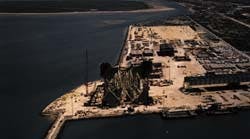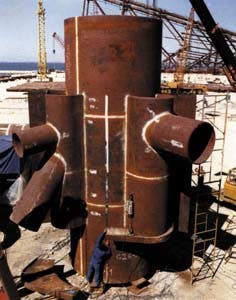Britannia: Is it the last of the giants?
Dragados sees potential for more North Sea jackets
The upended Britannia jacket at Dragados Offshore's recently expanded yard in Puerto Real.
Jacket node fabrication at Puerto Real.Piling of the Britannia Field jacket should be under way in the UKCS. Size is a key feature of this project, operated jointly by Chevron and Conoco. Not only is this Britain's biggest new gas/condensate development, but the platform may also be the last of the North Sea giants. Beyond Britannia, the future in this region looks increasingly ship-shaped.
Currently the 20,000-ton, 160-meter jacket is the main focus of attention. For the past 20 months, this has also been the chief offshore construction project for the Dragados Offshore yard in Puerto Real in southwest Spain. The finished structure was due to be skidded onto the Intermac 627 barge late last month for transport to the field.
Unlike the deck and the subsea facilities, the jacket was not included in one of the Britannia project alliances. Dragados' brief was simply to deliver the completed structure by June 25 at a fixed price. Assembly, which involved up to 1,000 personnel at the yard, was however supervised by a 20-strong Britannia team including civil and mechanical engineers, coating and welding inspectors and materials specialists.
The bulk of the tubulars were subcontracted to SIF Holland Offshore, which also supplied the piles. These tubulars were prefabricated from steel plates supplied by British Steel and Dillinger. Late last August, assembly began with the welding and roll-up of the jacket's two inner lower 1,500 metric ton steel frames. Roll-up of the inner upper 1,000 metric ton frames followed in October, which were then tied together by the well conductor frames.
The trickiest operation, however, was the lifting and joining this February of the 4,500-ton outer/side frames. Following a two-day delay due to bad weather, this was eventually completed in seven days by 40 people. Owing to the sheer size and weight of these components, Dragados and subcontractor PSC Heavy Lift used a combination of strain jacks and a few cranes to lift the frames to an angle of 50 degrees. Cranes alone did not have the necessary level of capacity and using the jacks allowed more accurate positioning.
Final stages of assembly centered on fitting and welding of the numerous bracing members that connect the outer frames to the inner core and the erection of two large flotation tanks in readiness for the load-out.
Britannia's substructure piles, also manufactured by SIF, are claimed to be the largest ever built for North Sea operation. In total 20 piles, each 123 meters long and 2.73 meters in diameter, will support the substructure. The semisubmersible crane vessel DB102 will lower the 560- ton tubes through vertical pile sleeeves framed into the jacket legs. A hydraulic hammer will then drive the piles 105 meters into the seabed, following which the annulus between sleeves and piles will be filled with high strength grout, forming the foundations for the platform.
The yellow jacket's four bottle legs, each weighing 900 tons, include five pile sleeves and mudmats. Other special features of the structure include two complex X cast, 32-ton nodes made by Sheffield Forgemasters in the UK. This design is said to achieve cost and weight savings over conventionally fabricated nodes.
Lifeline
Britannia came at a convenient time for Dragados. Although the company had a good track record in the offshore sector since establishing a yard (initially in Almeria) in 1972, work had tailed off in 1993, threatening closure of the Puerto Real site. Management reacted, however, by scaling staff right back to a basic team working for tenders. When Britannia came in, it proved relatively easy to mobilize sufficient construction personnel in an area historic for shipbuilding.The jacket was clinched against competition from UK and Italian yards. According to Business and Development Manager Gary Hudson, Dragados was one of the few sites with the facilities in place to handle this size substructure, including a 300-meter long loadout key and giant skid beams. No special investment was necessary.
Lately, the yard has also built the pre-assembled units for Texaco's Captain FPSO topsides and the turret for the converted FPSO Cairu, due to work for Petrobras in the Marlim Field.
Although Europe is currently obsessed with floaters and small platforms, Hudson sees possibilities for larger jackets further afield in West Africa and Indonesia's Natuna project. These could be built in Puerto Real, as local fabrication prowess in both regions may prove over-stretched.
"We don't have the capability to design jackets," says Hudson, "but we do have practical experience in weld configuration and how the design will affect the erection sequence." To compete with Gulf of Mexico yards on integrated platform fabrication, however, Dragados would need to align with a design house - this option is currently being explored.
Dragados is also interested in undertaking EPIC jobs off West Africa, through an alliance with an installation contractor that does not wish to branch into fabrication, or with a platform floatover specialist offering an alternative to costly heavy lifts. Again, talks are underway.
Despite missing out on the Bideford Dolphin, Dragados remains keen to undertake semisubmersible drilling rig conversions as well as TLP and Spar newbuilds. It may also team up with a US-based design company to offer concrete solutions, including seabed storage tanks.
The yard in Perto Real has been expanded from 25 hectares to 44 hectares this year to handle assembly of Scandinavia's new Oresund bridge link. Two new welding robots have been purchased for this project. Procedures for all types of welding and alloys can now be offered.
Copyright 1997 Oil & Gas Journal. All Rights Reserved.


